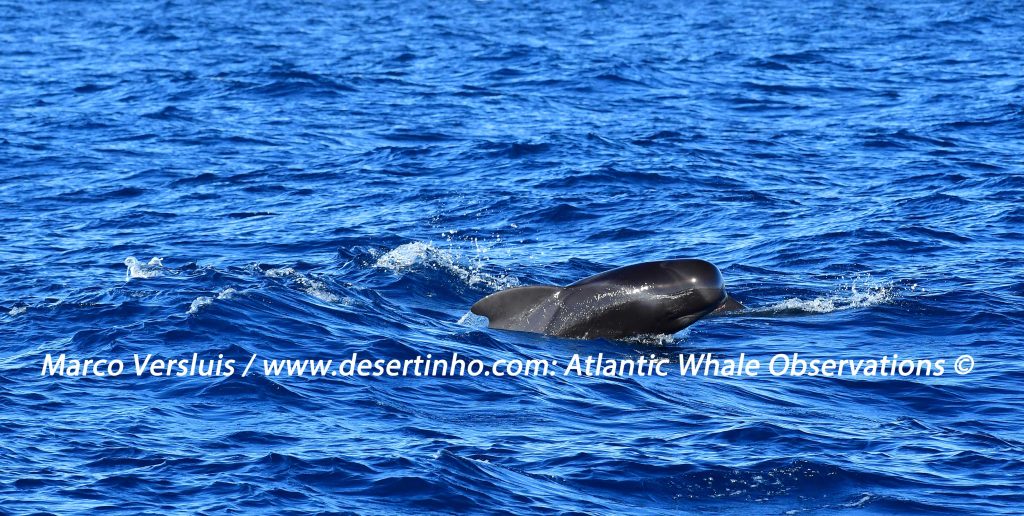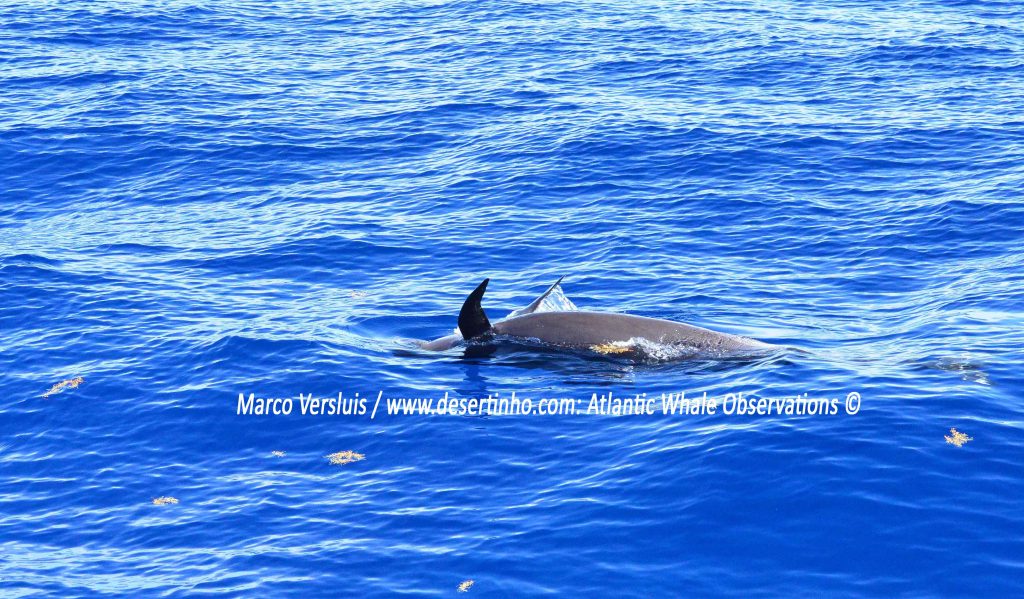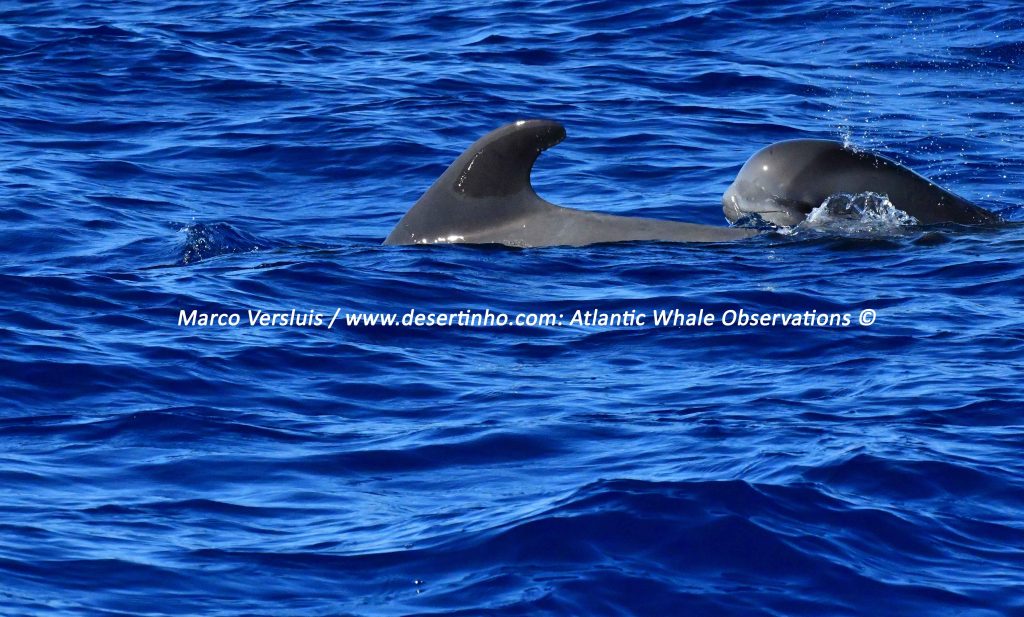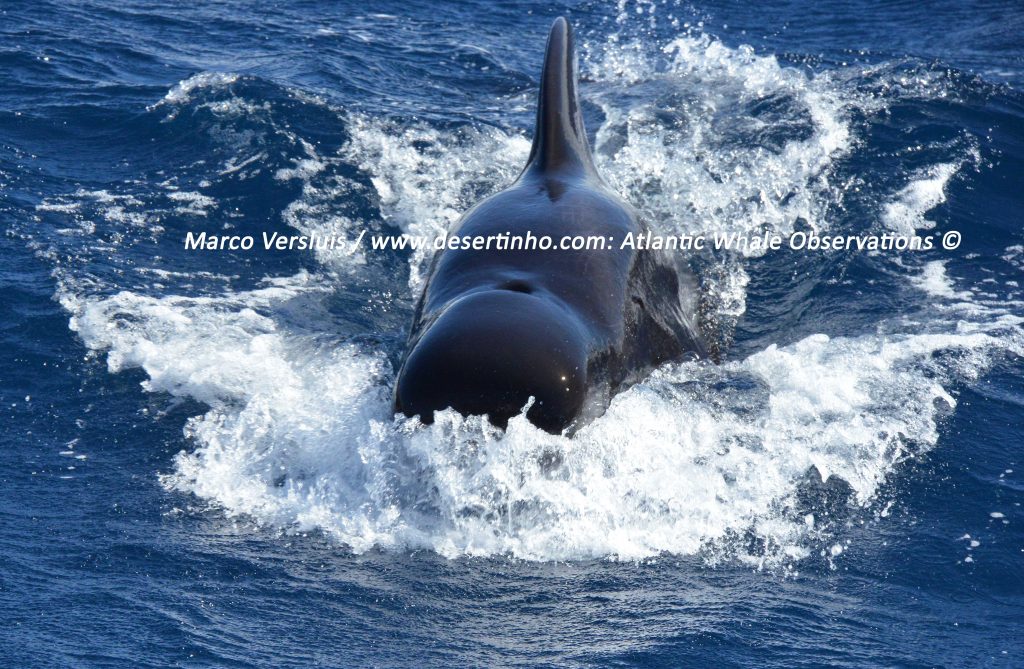Pilot whales in the Atlantic are divided into 2 different sub species: The Short-finned Pilot whale (Globicephala macrorhynchus) and the Long-finned Pilot whale (Globicephala melas). The most typical differences between the short-finned Pilot whale and his relative are: Their color, length, head shape, shorter petrol fins, 14-18 teeth in upper and lower jaw, and habitat in the South Atlantic. The most resident species in the South Atlantic is the short-finned Pilot whale. Both Pilot whale species are whales with a big temper, and they do have a typical hierarchy. One member of the pod is “The Pilot” and that’s the explanation why they are called Pilot whales. Pilot whales have one of the biggest self esteem within the dolphin family. Only the Risso’s dolphin, or Gramper, has more self esteem than a Pilot whale has. Important to mention it that both species get along very well, and they are often socializing together although they hunt on the same kind of prey.
Interesting to tell is that the big and shy Sperm whale bulls prefer to travel “around the corner” when there is a pod of Pilot whales nearby. All 3 toothed whale species as mentioned before are so called “vertical hunters”. They all dive vertical into the Atlantic to hunt their prey. Pilot whales their spectacular dorsal fin reminds me of a half moon and characteristic for Pilot whales is their bulbous forehead. From my point of view, they are the closest family members to the Orca (Orcinus orca). A normal pod size of both Pilot whale species is about 10 till even 100 individuals and their swimming speed is not that amazing, up to 30 km per hour. This dolphin species is not common near the coast of the Netherlands but there is a sandplate in the Wadden Sea that’s called “de Griend” which means “Pilot whale”.
Pilot whale facts: An adult male weigh about 1500 – 3000 KG and their length is about 5 – 6 meters. An adult female weigh about 1500 – 2000 KG and their lenght is about 3 – 4 meters. A newborn calf weigh about 60 KG and their length is than approximately 1.7 meters. A Pilot whale gives birth to a single calf during the summer after a gestation period of 1 year. The interval between giving birth to calves is usually 3 – 4 years and lactation lasts 15 months and is the estimated lifespan of a Pilot whale approximately up to 35 years. Pilot whales feed on various types of small fish and octopus and they can dive till a maximum of 900 meters deep for a maximum time of 15 minutes. Unfortunately, Pilot whales are still hunted in Europe! Annually The Grind, in Danish Grindabod, takes place near the Farour Islands (Denmark). For more information about that please watch the documentary Viking shores.
The pictures on this page of the short-fin pilot whale were made near the Azores and Madeira. Photos 1, 3, and 4 are from the last 3 years near Ilhas Desertas near Madeira. There is a resident pod of short-fin pilot whale in that region. Personally, I have been able to observe this species annually and you can recognize some individuals. Besides the calves you see on the photos you can also see the bull of the pod in photo 4. This is a really an impressive whale and the biggest one I’ve seen. Photo 2 was taken in the Azores. Short-fin pilot whales are also found there regularly but are not resident there.




In de Atlantische Oceaan komen er 2 soorten Grienden voor: de Kort-vin Griend (Globicephala macrorhynchus) en de Lang-vin Griend (Globicephala melas). De belangrijke verschillen tussen beide soorten zijn: Hun kleur, lengte, vorm van de kop, kortere voorvinnen, 14-18 tanden in boven en onderkaak, en hun leefomgeving de Zuid Atlantische Oceaan. Beide soorten Grienden zijn een “humeurige” walvissoort en is er binnen een “Pod” een bijzondere hiërarchie. 1 manlijke Griend is namelijk de “Piloot” van de pod en hij bepaalt alles binnen zijn pod. Dit is dan ook direct de verklaring voor hun naam “Pilot whales”. De “piloot” van de pod is altijd de sterkste en meest bepalende manlijke walvis. Je kunt ze eenvoudig herkennen aan hun imposante afmeting. De Griend is een tandwalvis die voor niets en niemand bang is. Zelfs manlijke potvissen zwemmen liever een “blokje om” als ze een groep Grienden horen. Bijzonder om te vermelden is dat Grienden vaak sociaal gedrag vertonen ten opzichte van de grijze dolfijn. De grijze dolfijn, ook wel Risso’s dolfijn of Gramper genoemd, is nog een “tandje” erger wat humeur betreft dan de Griend overigens.
Alle 3 de eerder genoemde tandwalvissen zijn zogenaamde “verticale jagers” wat betekend dat ze alle 3 diep moeten duiken voor hun voedsel dat hoofdzakelijk bestaat uit diverse inktvissoorten die leven op verschillende dieptes. Wat kenmerkend is voor de Griend is hun bolvormige vorm van de kop. Dezelfde bolvormige kop zie je ook terug bij de Orka (Orcinus orca). Een pod Grienden bestaat gemiddeld uit ongeveer 10 tot 100 Grienden en is hun zwemsnelheid niet bijzonder te noemen (circa 30 KM/ uur). In Nederland komen Grienden niet voor maar er is wel een zandplaat in de Waddenzee die is vernoemd naar deze dolfijn. Deze zandplaat wordt gebruikt door vogelaars. Een van de mooiste kenmerken van de griend vind ik de vorm van hun rugvin die de vorm heeft van een halve maan.
Hierbij specifieke informatie over de Griend: Een volwassen manlijke Griend weegt 1500 tot 3000 KG en hun lengte varieert tussen de 5 en 6 meter. Een volwassen vrouwelijke Griend weegt gemiddeld 1800 KG en hun lengte varieert tussen de 3 en 4 meter. Een kalf van de Griend weegt bij de geboorte 60 KG en is dan ongeveer anderhalve meter lang. Een kalf wordt eens in de 3 tot 4 jaar geboren na een draagtijd van een jaar. Zodra het kalf ter wereld is dan wordt het gedurende een periode van 15 maanden door de moeder gezoogd. De gemiddelde leeftijd van de Griend is 35 jaar. Hun voedsel bestaat hoofdzakelijk uit kleine vissoorten en octopus. Grienden kunnen duiken tot een diepte van 900 meter en kunnen maximaal 15 minuten lang onder water blijven. Tot slot wordt de Griend nog steeds bejaagd. Zelfs in Europa! Jaarlijks vindt er een jacht plaats bij de Faeröer eilanden (Denemarken) en is deze jacht genaamd de The Grind (in het Deens Grindabod). Wil je hier meer over weten dan raad ik je aan om de documentaire Viking shores te kijken.
De foto’s op deze pagina van de kort-vin Grienden zijn gemaakt bij de Azoren en bij Madeira. Foto’s 1, 3, en 4 zijn van de afgelopen 3 jaar nabij Ilhas Desertas bij Madeira. In deze regio bevindt zich een residente pod kort-vin Grienden. Persoonlijk heb ik deze soort jaarlijks kunnen observeren en herken je sommige individuen dan ook. Naast de kalfjes die je op de foto’s ziet zie je ook de stier van de pod op foto 4. Dit is echt een indrukwekkende walvis en de grootse die ik ook heb gezien. Foto 2 is gemaakt in de Azoren. Kort-vin Grienden komen daar ook regelmatig voor maar zijn daar niet resident.